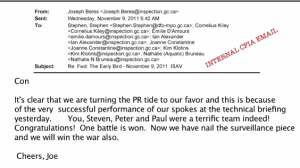
Cause of Heart Disease in Salmon Solved with Next-gen Sequencing, but....
The title story of this commentary is not news, because the related paper was published in PLOS One in 2010. It represented a success story of cheap next- gen sequencing with immediate social benefit.
Farm-raised salmons in Norway were found to have an infectious disease that was first recognized in 1999.
The marine farmed Atlantic salmon (Salmo salar L.) exhibits a variety of cardiac diseases, and the reason for this likely includes low activity in relatively confined spaces, continuous food supply, low oxygen level, crowding, stress in handling, and temperature [1]. The cardiac anomalies and defects of Atlantic salmon include aplasia or hypoplasia of the septum transversum, abnormal location and shape of heart [1], arteriosclerosis [2, 3], and ventricular hypoplasia [4], but specific diseases include cardiomyopathy syndrome (CMS) [57], pancreas disease (PD) [810], and heart and skeletal muscle inflammation (HSMI) [11, 12]. Annual economical losses due to cardiomyopathy syndrome (CMS) alone have been estimated up to 4.58.8 millions [7].
Heart and skeletal muscle inflammation (HSMI) is a disease of marine farmed Atlantic salmon reported from Norway, Scotland and Chile. HSMI is a disease which mainly affects heart and red skeletal muscle. It is typically a disease of moderate mortality (~20%) but high morbidity (~100%) that affects fish 5 to 9 months after transfer to sea.
Quite surprisingly, HSMI disease spread to large number of Salmon farms in Norway and then to as far as Chile. Moreover, the disease turned out to be often fatal to the farm-raised salmon, but its cause was not understood. In 2009, Kongtorp PhD thesis covered the topic.
In her doctorate, Kongtorp described the disease and compared the pathological findings to those of a number of known diseases such as pancreas disease (PD) and cardiomyopathy syndrome (CMS). Both field sampling and contact infection trials indicate that HMSI is a new disease caused by an unknown organism.
Then a group led by Gustavo Palacios used inexpensive next-gen sequencing to figure it all out.
Here we provide evidence that HSMI is associated with infection with a novel reovirus. Piscine reovirus (PRV) was identified through high-throughput pyrosequencing of serum and heart tissue of experimentally infected fish using novel frequency analysis methods as well as standard alignment methods.
RNA extracted from heart of a salmon with experimentally induced HMSI was pyrosequenced[5] yielding 106,073 reads ranging in size up to 598 nucleotide (average = 349.7, SD = 149.5). Although database alignment analysis at the nucleotide level revealed no evidence of infection, the predicted amino acid sequence of one 265 nucleotide read was 49% similar to the core-spike protein ?2 of Mammalian orthoreovirus 3 (AF378009). A real time PCR assay based on this sequence was used to test for the presence of the candidate virus in RNA extracts of heart and serum obtained from salmon with HSMI in association with spontaneous outbreaks (n = 20) or experimental infection (n = 20), and in non- infected control fish (n = 20). All samples from salmon with HSMI contained the candidate sequences. No sequences were found in the control salmon without HSMI.
Researchers in Norway are continuing to work on this topic and published the following paper in 2013.
We could end here describing how next-gen sequencing determined the cause of a rapidly spreading infectious disease and would have even more benefit given how fast sequencing costs have been falling. However, the story took a different turn.
In 2013, a Canadian biologist reported to have found the same virus in salmon’s of British Columbia (BC). She also found more lethal ISA (infectious salmon anemia) virus in BC salmons. Interestingly, instead of sending her few next-gen sequencing machines, the governments took a different and innovative action to stop the spread of virus.
The World Organization for Animal Health (OIE), our global first line of defence against farm animal epidemics, just stacked the odds against stopping ISA virus from spreading in British Columbia. They stripped the lab I am using to track ISA virus of its international certification.
I became concerned ISA virus could be spreading into the North Pacific from the Atlantic salmon feedlots when I read the BC government’s many reports of the “classic lesions associated with ISA virus infection” in the Atlantic salmon being reared in BC.
A small team of us have now sampled farm salmon from supermarkets across Canada and wild salmon throughout BC and I sent them to the closest ISA virus reference lab, Dr. Kibenge’s lab at the Atlantic Veterinary College. This was the lab that diagnosed ISA virus in Chile, just before the virus went epidemic causing $2 billion in damages. No one in Chile recognized they had ISA until Kibenge diagnosed it, but by then it was too late. The virus had come from Norway in farm salmon eggs and raged through the country killing salmon.
British Columbia is currently rated as an ISA-free region by the OIE and this brings considerable value to the BC farm salmon product. The USA has stated they do not want ISA virus contaminated salmon, so being ISA-free is critical to accessing the enormous US market, to the survival of the Norwegian salmon feedlot industry using BC to grow its fish.
The reporting of HSMI virus was dealt in equally prudent manner.
Norwegian Salmon Virus in BC met with regulatory silence
In summary, cheap technology itself is not panacea. The good, bad or no use depends on what the humans decide to do with it. In this case, the government agencies, likely captured by fish industry, are risking complete wipe out of wild salmon population to provide cover for their fish farms for a few months. While this researcher was trying to carefully investigate a serious disease outbreak, the government agency took it as a ‘PR battle’ and case for surveillance on the biologist, as the following internal email of the agency shows.

-————————————————
Readers may find the following two videos on related topics informative.
-————————————————-